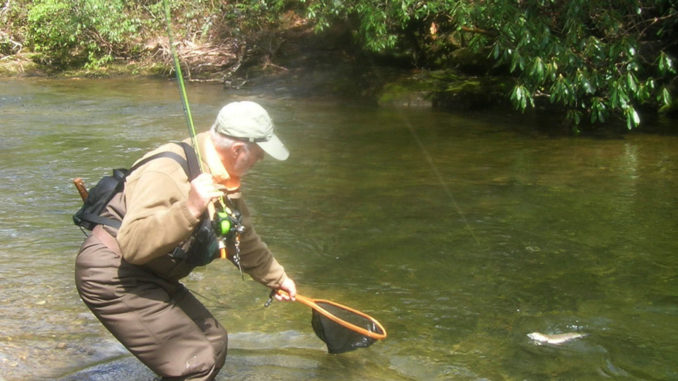
State’s special program has 33 bodies of water in 18 western counties.
The late Lee Wulff, a master fly-fisherman, once wisely stated, “Gamefish are too valuable to be caught only once.” That goes directly to the heart of delayed-harvest trout fishing, a system that serves the catch-and release-fisherman as well as the angler that desires to keep his catch for a nice fish dinner.
Personally, I enjoy fishing in the fall, winter and spring on delayed-harvest streams because of the possibility of constant action. In addition to the numerous fish in the 10- to 12-inch range, the occasional brood fish that is stocked or a holdover from previous stockings can add the element of surprise. Several occasions come to mind when these large fish responded, making the day special.
One such situation occurred on the North Mills River in Henderson County, where a friend and I fish several times a year during the delayed-harvest period. On this particular day, I had already caught and released a number of rainbows, brooks and a couple of browns. Moving downstream, I approached a nice pool in a river bend. A stealthy entry at the bottom of the pool allowed me to catch a couple of decent rainbows in the depths.
Moving slightly upstream, a dark shadow was evident in the fast riffles above the pool. The shadow was in a pocket of water the size of a bathtub, only a couple of feet deep. I tied on a No. 14 black stonefly nymph and cast diagonally above the riffle so that the nymph would approach the spot without the line crossing it first.
As soon as the nymph hit the pocket, the line tightened, and an a nice 14-inch rainbow came to the net after a spirited struggle. After a moment of admiration, it was released. This fish just couldn’t possibly have been the big shadow that had appeared earlier in the pocket. After allowing time for the fish to settle down, a repeat cast was made. Again, as soon as the fly entered the small pool, a fish struck savagely — on obviously above-average for the stream.
We battled up and down the stream, my 5-weight rod against a magnificent trout. Finally, he tired and was coached into the shallows at my feet. I rarely use a net, so I wet my hand to try to lift him for a quick photo. He was beautiful, with the pink stripe, black spots and silver back and belly of a rainbow. As I bent to lift him, he made one last mad dash downstream. As he approached a submerged snag, I applied pressure to turn him, and the hook pulled loose.
I thought, “All I wanted was a photo,” but it was not to be. He had his freedom, and I had a beautiful memory. He appeared to be approximately 26 inches long, with a large girth. His tail and fins were not worn from the concrete raceways of the hatchery. He was likely a holdover from previous seasons and had acclimated to the wild, or one of the wild reproducing trout that occasionally survive by being wily. Perhaps he had remained hidden in the overhanging recesses of the rocky ledge in the deep pool.
This is a familiar scenario on delayed-harvest streams. As if catching average-sized trout consistently were not enough, the possibility of encountering a trophy-sized trout is always a bonus.
Kevin Howell, owner of Davidson River Outfitters, is no stranger to delayed-harvest streams. A well-known fly fisherman and innovative fly-tier, he is a qualified guide. As an authority on fly fishing, he is very supportive of the delayed- harvest program.
“Overall, the quality is great, but the only problem is over-crowding and sometime rude anglers on some streams,” he aid. “Anglers need to be sure to give fellow fishermen as much room as they would want if they were fishing a particular pool or stretch of water. The fish size can vary from year to year, depending on the available amount of water at the hatchery to raise fish.
“Not only does the delayed-harvest program offer a great opportunity for anglers, but it has become a great tourism draw for counties like Jackson and Transylvania. This has a great effect on the local economy and job base.”
Gene Cunningham and I enjoyed a typical day on a delayed-harvest stream, the East Fork French Broad River, on a bleak day last November. This stream is heavily fished but consistently yields good results. It is in a populated area and easily accessible, as much of it runs parallel to a road.
We arrived about 8:30 a.m. and rigged our rods for action. I hit the water near a bridge where I had caught an 18-inch rainbow on a previous trip. The pool had filled in with sediment and leaves and didn’t yield the hoped-for results. A move upstream to a nice run with large boulder providing holding spots in the current gave up a couple of 9- to 11-inch rainbows. Several subsequent moves resulted in some larger, but non-trophy rainbows. The icy cold water had invigorated the fish, and they fought well.
Cunningham had moved upstream, and when I caught up with him, we were running nip and tuck on caught fish. I caught a couple more and he caught four more. We ended up with 21 fish between us, with him bringing 12 to net. The highlight of his day was a fat rainbow that Cunningham caught upstream from where we ended our trip. He laid it alongside the marks on his wading staff and it measured 15 inches. Not bad for delayed-harvest fly fishing.
The N.C. Wildlife Resources Commission has implemented delayed-harvest regulations on 33 trout waters in 18 western counties. Between Oct. 1 and June 6, no natural bait is allowed, and only single-hook artificial lures are legal. At 6 a.m. on June 7, anglers ages 16 and under get the streams to themselves for six hours, as regulations revert to hatchery supported: a 7-fish daily creel limit and no size minimum. The adults get to enter the fray at noon.
High densities of trout are stocked in these streams to provide anglers with optimal opportunities for success. Diamond-shaped, black-and-white signs, are posted designating delayed- harvest waters, and anglers are advised to respect the postings.

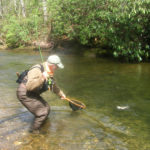
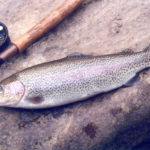

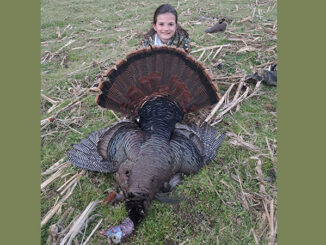
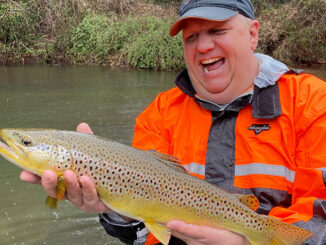
Be the first to comment